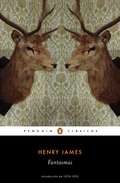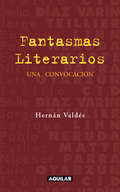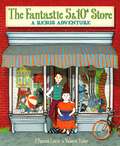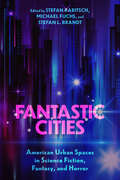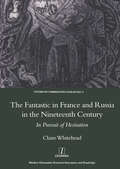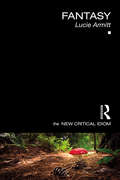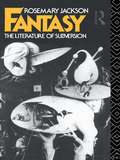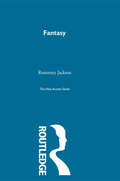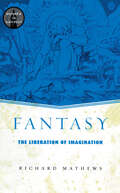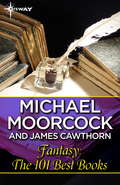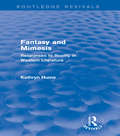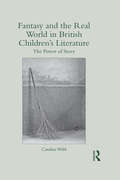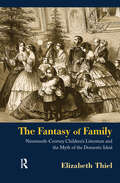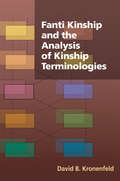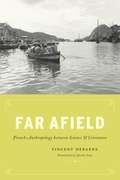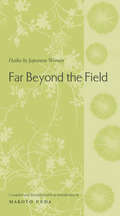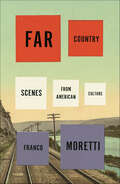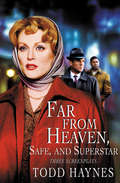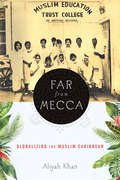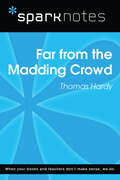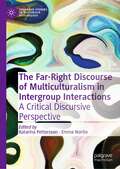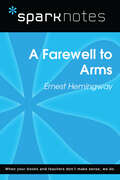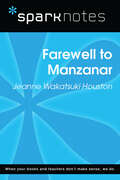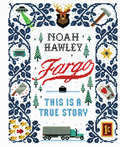- Table View
- List View
Fantasmas
by Henry JamesLos mejores libros jamás escritos. «Si no puedes creer en ellos, no los molestes...» Si bien Henry James fue un refinado prosista de dramas costumbristas, no menos notable es su aportación al ámbito de la intriga y el suspense. Profundamente interesado en el terreno de lo sobrenatural, no dejó sin explorar ningún tipo de experiencia extrasensorial, ni se abstuvo de analizar al detalle los demonios que, en cualesquiera formas, perturban al ser humano. Este volumen recoge el grueso de su narrativa breve fantástica y fantasmagórica. Precede a los relatos el magistral estudio de Leon Edel -considerado unánimemente el mayor especialista en la obra de James del siglo XX-, quien también redactó una minuciosa nota preliminar para cada uno de ellos. Como colofón, reproducimos el ensayo del propio James «¿Hay vida después de la muerte?», que refleja las inquietudes del autor sobre el más allá. Reseña:«Aél le interesa el drama psicológico, el desgarro o la epifanía, de ahí tantas adaptaciones al cine.»Núria Escur, La Vanguardia «Henry James siempre es inspirador y decididamente contemporáneo. Jaume Bonfill, de Penguin Clásicos afirma que su relevancia no solo es histórica, ya que tiene "recursos y sorpresas que los lectores de hoy siguen percibiendo como novedosos, y que asimismo aún ponen en práctica, por ejemplo, los guionistas de cine o televisión".»Ana Llurba, Letras Libres
Fantasmas literarios
by Hernán ValdésEl mundo literario chileno de los años 50 a los 70 tras bambalinas a través de la mirada de un testigo privilegiado. Hernán Valdés, el autor de Tejas Verdes, convoca a varias generaciones de literatos y sus mundos literarios -los fantasmas-, y nos conduce por una aventura novelesca en la que sus vidas, esto es su cultura, ideas, pasiones y andanzas, aparecen ante nosotros en su inmediato acontecer, en su presente, en las décadas del 50, 60 y 70: pobreza, sueños y amoríos; grandezas y flaquezas en las vidas de Jorge Teillier, Teófilo Cid, Stella Díaz Varín, Enrique Lihn, Pablo Neruda, Esther Matte, Nicanor Parra y los demás.Algunos podrán leer este libro como un documento novelado, otros, como una novela documental. En cualquier caso, la experiencia será la de una inmersión en una forma de vida, en un mundo de valores estéticos y morales que hoy en día parecen idos y cuya nostalgia se acrecienta. Con el lenguaje poético, la lucidez y la ironía que han caracterizado sus anteriores escritos, Valdés ofrece un emotivo y revelador ejercicio de la memoria. Por estas páginas desfilan con toda su humanidad los fantasmas vivos y muertos de un escritor que a fuerza de vivir tantos años lejos de Chile, ha llegado a convertirse él mismo en un fantasma.
The Fantastic 5 & 10 Cent Store: A Rebus Adventure
by J. Patrick LewisWhat lurks inside that mysterious store at the end of town? Only Benny Penny is adventurous enough to find out. . . . In this book, you can read the words and the pictures. Perfect for children just learning to read, this silly, kid-friendly rebus picture book is sure to be a hit in the classroom and at home. (In a rebus, words are represented by images, or by an image plus a letter. And even beginning readers can take pleasure in reading pictures!) The pairing of Valorie Fisher&’s full-page art with J. Patrick Lewis&’s funny rhyming poem will give young readers plenty of clues for solving these fun and engaging picture puzzles.
Fantastic Cities: American Urban Spaces in Science Fiction, Fantasy, and Horror
by Stefan Rabitsch, Michael Fuchs and Stefan L. BrandtContributions by Carl Abbott, Jacob Babb, Marleen S. Barr, Michael Fuchs, John Glover, Stephen Joyce, Sarah Lahm, James McAdams, Cynthia J. Miller, Fernando Gabriel Pagnoni Berns, Chris Pak, María Isabel Pérez Ramos, Stefan Rabitsch, J. Jesse Ramírez, A. Bowdoin Van Riper, Andrew Wasserman, Jeffrey Andrew Weinstock, and Robert Yeates Metropolis, Gotham City, Mega-City One, Panem’s Capitol, the Sprawl, Caprica City—American (and Americanized) urban environments have always been a part of the fantastic imagination. Fantastic Cities: American Urban Spaces in Science Fiction, Fantasy, and Horror focuses on the American city as a fantastic geography constrained neither by media nor rigid genre boundaries. Fantastic Cities builds on a mix of theoretical and methodological tools that are drawn from criticism of the fantastic, media studies, cultural studies, American studies, and urban studies. Contributors explore cultural media across many platforms such as Christopher Nolan’s Dark Knight Trilogy, the Arkham Asylum video games, the 1935 movie serial The Phantom Empire, Kim Stanley Robinson’s fiction, Colson Whitehead’s novel Zone One, the vampire films Only Lovers Left Alive and A Girl Walks Home Alone at Night, Paolo Bacigalupi’s novel The Water Knife, some of Kenny Scharf’s videos, and Samuel Delany’s classic Dhalgren. Together, the contributions in Fantastic Cities demonstrate that the fantastic is able to “real-ize” that which is normally confined to the abstract, metaphorical, and/or subjective. Consequently, both utopian aspirations for and dystopian anxieties about the American city become literalized in the fantastic city.
The Fantastic in France and Russia in the 19th Century: In Pursuit of Hesitation
by Claire Whitehead"Hesitation between a natural or supernatural interpretation of fictional events is the life-blood of the fantastic; but just how is this hesitation provoked? In this detailed and insightful study, Claire Whitehead uses examples from nineteenth-century French and Russian literature to provide a range of narrative and syntactic answers to this question. A close reading of eight key works by Alexander Pushkin, Vladimir Odoevskii, Nikolai Gogol, Fedor Dostoevskii, Theophile Gautier, Prosper Merimee and Guy de Maupassant illustrates how ambiguity is provoked by such factors as point of view, multiple voice and narrative authority. The analysis of hesitation experienced in works depicting madness or ironic self-consciousness advocates the inclusion in the genre of previously marginalized texts. The close comparison of works from these two national traditions shows that the fundamental discursive features of the fantastic do not belong to any one language."
Fantasy (The New Critical Idiom)
by Lucie ArmittFantasy provides an invaluable and accessible guide to the study of this fascinating field. Covering literature, film, television, ballet, light opera and visual art and featuring a historical overview from Ovid to the Toy Story franchise, this book takes the reader through the key landmark moments in the development of fantasy criticism. This comprehensive guide examines fantasy and politics, fantasy and the erotic, quest narratives and animal fantasy for children. The versatility and cultural significance of fantasy is explored, alongside the important role fantasy plays in our understanding of ‘the real’, from childhood onwards. Written in a clear, engaging style and featuring an extensive glossary of terms, this is the essential introduction to Fantasy.
Fantasy: The Literature of Subversion (New Accents)
by Dr Rosemary JacksonThis study argues against vague interpretations of fantasy as mere escapism and seeks to define it as a distinct kind of narrative. A general theoretical section introduces recent work on fantasy, notably Tzventan Todorov's The Fantastic: A Structural Approach to a Literary Genre (1973). Dr Jackson, however, extends Todorov's ideas to include aspects of psychoanalytical theory. Seeing fantasy as primarily an expression of unconscious drives, she stresses the importance of the writings of Freud and subsequent theorists when analysing recurrent themes, such as doubling or multiplying selves, mirror images, metamorphosis and bodily disintegration.^l Gothic fiction, classic Victorian fantasies, the 'fantastic realism' of Dickens and Dostoevsky, tales by Mary Shelley, James Hogg, E.T.A. Hoffmann, George Eliot, Henry James, Joseph Conrad, R.L. Stevenson, Franz Kafka, Mervyn Peake and Thomas Pynchon are among the texts covered. Through a reading of thse frequently disquieting works, Dr Jackson moves towards a definition of fantasy expressing cultural unease. These issues are discussed in relation to a wide range of fantasies with varying images of desire and disenchantment.
Fantasy: The Literature Of Subversion (New Accents Ser.)
by Rosemary JacksonFirst Published in 2002. Routledge is an imprint of Taylor & Francis, an informa company.
Fantasy: The Liberation of Imagination (Studies In Literary Themes And Genres #Vol. 16)
by Richard MathewsUsing a broad definition of fantasy to include myth, folklore, legend and fairy tale, this survey of the genre will entice as well as inform any student interested in the mysterious, mystical or magical. Beloved authors like J. R. R. Tolkien, Ursula K. Le Guin, William Morris and Robert E. Howard are examined closely.
Fantasy: The 101 Best Books
by Michael Moorcock James CawthornFantasy is one of the most appealing and yet most puzzling of literary genres. Appealing because it can offer dreams, the fulfillment of wishes, and escape; but puzzling because it spans such a wide and diverse range of books. In Fantasy: The 100 Best Books, James Cawthorn and Michael Moorcock present a wide-ranging cross-section of the fantasy genre, from its eighteenth century Gothic origins through nineteenth century literary classics, pulp-era weird fiction, and on to modern favorites. Recognized classics are accompanied by lesser-known works ripe for rediscovery, resulting in an interestingly idiosyncratic and uniquely valuable guide to two-and-a-half centuries of fantastic stories.
Fantasy and Mimesis: Responses to Reality in Western Literature (Routledge Revivals)
by Kathryn HumeSince Plato and Aristotle’s declaration of the essence of literature as imitation, western narrative has been traditionally discussed in mimetic terms. Marginalized fantasy- the deliberate from reality – has become the hidden face of fiction, identified by most critics as a minor genre. First published in 1984, this book rejects generic definitions of fantasy, arguing that it is not a separate or even separable strain in literary practice, but rather an impulse as significant as that of mimesis. Together, fantasy and mimesis are the twin impulses behind literary creation. In an analysis that ranges from the Icelandic sagas to science fiction, from Malory to pulp romance, Kathryn Hume systematically examines the various ways in which fantasy and mimesis contribute to literary representations of reality. A detailed and comprehensive title, this reissue will be of particular value to undergraduate literature students with an interest in literary genres and the centrality of literature to the creative imagination.
Fantasy and the Real World in British Children's Literature: The Power of Story (Children's Literature and Culture)
by Caroline WebbThis study examines the children’s books of three extraordinary British writers—J.K. Rowling, Diana Wynne Jones, and Terry Pratchett—and investigates their sophisticated use of narrative strategies not only to engage children in reading, but to educate them into becoming mature readers and indeed individuals. The book demonstrates how in quite different ways these writers establish reader expectations by drawing on conventions in existing genres only to subvert those expectations. Their strategies lead young readers to evaluate for themselves both the power of story to shape our understanding of the world and to develop a sense of identity and agency. Rowling, Jones, and Pratchett provide their readers with fantasies that are pleasurable and imaginative, but far from encouraging escape from reality, they convey important lessons about the complexities and challenges of the real world—and how these may be faced and solved. All three writers deploy the tropes and imaginative possibilities of fantasy to disturb, challenge, and enlarge the world of their readers.
The Fantasy of Family: Nineteenth-Century Children's Literature and the Myth of the Domestic Ideal (Children's Literature and Culture)
by Elizabeth ThielThe myth of the Victorian family remains a pervasive influence within a contemporary Britain that perceives itself to be in social crisis. Nostalgic for a golden age of "Victorian values" in which visions of supportive, united families predominate, the common consciousness, exhorted by social and political discourse, continues to vaunt the "traditional, natural" family as the template by which all other family forms are gauged. Yet this fantasy of family, nurtured and augmented throughout the Victorian era, was essentially a construct that belied the realities of a nineteenth-century world in which orphanhood, fostering, and stepfamilies were endemic. Focusing primarily on British children's texts written by women and drawing extensively on socio-historic material, The Fantasy of Family considers the paradoxes implicit to the perpetuation of the domestic ideal within the Victorian era and offers new perspectives on both nineteenth-century and contemporary society.
Fanti Kinship and the Analysis of Kinship Terminologies
by David B. KronenfeldThis book examines Fanti kinship terminology from a variety of analytic and formal perspectives. Based on work with a broad number of informants, David B. Kronenfeld details and analyzes internal variation in usage within the Fanti community, shows the relationship between terminology and social groups and communicative usage, and relates these findings to major theoretical work on kinship and on the intersections of language, thought, and culture. The terminological analysis in this study employs a great variety of formal approaches, assesses the strengths and weaknesses of each approach, and covers a wide range of types of usage. This work also performs a systematic, formal analysis of behavior patterns among kin, joining this approach with the analysis of a kinship terminological system. Rather than treating kinship terminology as a special, isolated piece of culture, this study also ties its analysis to more general semantic and cultural theoretical issues. Including computational and comparative studies of kinship terminologies, this volume represents the fullest analysis of any kinship terminological system in the ethnographic record.
Far Afield: French Anthropology between Science and Literature
by Vincent Debaene translated by Justin IzzoAnthropology has long had a vexed relationship with literature, and nowhere has this been more acutely felt than in France, where most ethnographers, upon returning from the field, write not one book, but two: a scientific monograph and a literary account. In Far Afield#151;brought to English-language readers here for the first time#151;Vincent Debaene puzzles out this phenomenon, tracing the contours of anthropology and literature’s mutual fascination and the ground upon which they meet in the works of thinkers from Marcel Mauss and Georges Bataille to Claude Lévi-Strauss and Roland Barthes. The relationship between anthropology and literature in France is one of careful curiosity. Literary writers are wary about anthropologists’ scientific austerity but intrigued by the objects they collect and the issues they raise, while anthropologists claim to be scientists but at the same time are deeply concerned with writing and representational practices. Debaene elucidates the richness that this curiosity fosters and the diverse range of writings it has produced, from Proustian memoirs to proto-surrealist diaries. In the end he offers a fascinating intellectual history, one that is itself located precisely where science and literature meet.
Far Beyond the Field: Haiku by Japanese Women
by Makoto UedaFar Beyond the Field is a first-of-its-kind anthology of haiku by Japanese women, collecting translations of four hundred haiku written by twenty poets from the seventeenth century to the present. By arranging the poems chronologically, Makoto Ueda has created an overview of the way in which this enigmatic seventeen-syllable form has been used and experimented with during different eras. At the same time, the reader is admitted to the often marginalized world of female experience in Japan, revealing voices every bit as rich and colorful, and perhaps even more lyrical and erotic, than those found in male haiku.
Far Beyond the Field: Haiku by Japanese Women (Translations From The Asian Classics Ser.)
by Ueda Makoto Ed.Far Beyond the Field is a first-of-its-kind anthology of haiku by Japanese women, collecting translations of four hundred haiku written by twenty poets from the seventeenth century to the present. By arranging the poems chronologically, Makoto Ueda has created an overview of the way in which this enigmatic seventeen-syllable form has been used and experimented with during different eras. At the same time, the reader is admitted to the often marginalized world of female experience in Japan, revealing voices every bit as rich and colorful, and perhaps even more lyrical and erotic, than those found in male haiku.Listen, for instance, to Chiyojo, who worked in what has been long thought of as the dark age of haiku during the eighteenth century, but who composed exquisitely fine poems tracing the smallest workings of nature. Or Katsuro Nobuko, who wrote powerfully erotic poems when she was widowed after only two years of marriage. And here, too, is a voice from today, Mayuzumi Madoka, whose meditations on romantic love represent a fresh new approach to haiku.
Far Country: Scenes from American Culture
by Franco MorettiThe influential and controversial critic takes literary history out of the classroom and into the publicIn the field of literary history and theory, Franco Moretti is synonymous with innovation. The cofounder of the Stanford Literary Lab, he brought quantitative methods into the study of the novel, enabling a “distant” reading that uses computation to analyze literary production over centuries. But at the same time, he was also teaching undergraduates the history of literature. Knowing Moretti, it’s no surprise that he didn’t teach the course the accepted way: one author after another, in a long uninterrupted chain. Instead, he put an irregular chessboard in front of his students that was too strange to be taken for granted. Literary history had become a problem, and he offered a solution.In Far Country, Moretti take these lectures out of the classroom and lets us share in the passion and excitement that comes from radical critique. Unconstrained by genre, Moretti juxtaposes Whitman and Baudelaire, the Western and film noir, even Rembrandt and Warhol, illuminating each through their opposition. With his guidance, we revel in the process of transformation—the earthquakes that shook the “how” of artistic form—and begin to shape a new view on American culture.Bracing in its insight and provocative in its conclusions, Far Country is a critical look at the development of American cultural hegemony.
Far From Heaven, Safe, and Superstar: Three Screenplays
by Todd HaynesThree acclaimed screenplays from one of today’s most provocative filmmakers, including the Oscar nominated screenplay Far from Heaven. An award-winning auteur and a pioneer of the New Queer Cinema movement, Todd Haynes has achieved both critical acclaim and box office success with his original, intelligent, and often controversial films. Collected here are three of his most celebrated screenplays. Far from Heaven: Winning fifty critics’ prizes and appearing on two hundred Top Ten lists, Far from Heaven was also nominated for four Academy Awards. Inspired by the films of Douglas Sirk, it tells the story of a 1950s housewife who is alienated by her neighbors when she pursues an affair with her African American gardener after learning of her husband’s homosexuality. Safe: Haynes’s breakthrough feature was voted Best Film of the 1990s by the Village Voice Film Critics Poll. It tells the disturbing story of an affluent suburban housewife whose life is shattered by a mysterious illness. One character suggests that perhaps she is “allergic to the twentieth century.” Superstar: The Karen Carpenter Story: Told with a cast of Barbie dolls, this short film about Karen Carpenter’s battle with anorexia was named one of Entertainment Weekly’s Top 50 Cult Movies in 2003. Though the film was ordered destroyed after a lawsuit by the Carpenter estate, it remains an underground classic and “the most talked-about, least-seen film of the ’80s” (The A.V. Club).
Far from Mecca: Globalizing the Muslim Caribbean (Critical Caribbean Studies)
by Aliyah KhanFar from Mecca: Globalizing the Muslim Caribbean is the first academic work on Muslims in the English-speaking Caribbean. Khan focuses on the fiction, poetry, and music of Islam in Guyana, Trinidad, and Jamaica. Combining archival research, ethnography, and literary analysis, Khan argues for a historical continuity of Afro- and Indo-Muslim presence and cultural production in the Caribbean. Case studies explored range from Arabic-language autobiographical and religious texts written by enslaved Sufi West Africans in nineteenth-century Jamaica, to early twentieth-century fictions of post-indenture South Asian Muslim indigeneity and El Dorado, to the attempted government coup in 1990 by the Jamaat al-Muslimeen in Trinidad, as well as the island’s calypso music, to contemporary judicial cases concerning Caribbean Muslims and global terrorism. Khan argues that the Caribbean Muslim subject, the “fullaman,” a performative identity that relies on gendering and racializing Islam, troubles discourses of creolization that are fundamental to postcolonial nationalisms in the Caribbean.
Far from the Madding Crowd (SparkNotes Literature Guide Series)
by SparkNotesFar from the Madding Crowd (SparkNotes Literature Guide) by Thomas Hardy Making the reading experience fun! Created by Harvard students for students everywhere, SparkNotes is a new breed of study guide: smarter, better, faster.Geared to what today's students need to know, SparkNotes provides:chapter-by-chapter analysis explanations of key themes, motifs, and symbols a review quiz and essay topics Lively and accessible, these guides are perfect for late-night studying and writing papers.
The Far-Right Discourse of Multiculturalism in Intergroup Interactions: A Critical Discursive Perspective (Palgrave Studies in Discursive Psychology)
by Katarina Pettersson Emma NortioThis book employs discursive psychology to examine how far-right discourse on issues related to multiculturalism is received, interpreted, adapted and contested in political rhetoric and informal talk. It brings together the latest research from sociology and media studies concerning the circulation of far-right messages in the era of digitalization and the ‘hybrid media system’, and critical discursive psychology research into political and lay discourse pertaining to multiculturalism. Drawing on empirical material from the Nordic context allows for an analysis of political discourse within societies in which a strong tradition of social democratic welfare states now exists alongside the rise of populist and far-right parties. Operating in countries with comparatively high national internet and social media penetration, this book explores the extent to which the success of these parties is linked to their skilful use of social media, in order to mobilise popular support for their political agendas. The collection’s multilevel perspective aims to further the understanding of how the anti-immigration and anti-multiculturalist ideologies propagated by these parties contributes to the mainstreaming of their rhetoric among the political ‘elite’, as well as to the societal normalization of nationalist and xenophobic discourse. In doing so it will provide fresh insights for students and scholars of sociology, social psychology, discourse analysis, media and communication, and political science.
A Farewell to Arms (SparkNotes Literature Guide Series)
by SparkNotesA Farewell to Arms (SparkNotes Literature Guide) by Ernest Hemingway Making the reading experience fun! Created by Harvard students for students everywhere, SparkNotes is a new breed of study guide: smarter, better, faster.Geared to what today's students need to know, SparkNotes provides:chapter-by-chapter analysis explanations of key themes, motifs, and symbols a review quiz and essay topics Lively and accessible, these guides are perfect for late-night studying and writing papers.
Farewell to Manzanar (SparkNotes Literature Guide Series)
by SparkNotesFarewell to Manzanar (SparkNotes Literature Guide) by Jeanne Wakatsuki Houston Making the reading experience fun! Created by Harvard students for students everywhere, SparkNotes is a new breed of study guide: smarter, better, faster.Geared to what today's students need to know, SparkNotes provides:chapter-by-chapter analysis explanations of key themes, motifs, and symbols a review quiz and essay topics Lively and accessible, these guides are perfect for late-night studying and writing papers.
Fargo: This Is a True Story
by Noah HawleyThe making of the acclaimed, award-winning TV show told exactly as it occurred.From bestselling, Edgar Award-winning author Noah Hawley (Before the Fall) comes the perfect collector's item to the hit TV show based on the film Fargo. This companion to the first three seasons of Fargo, which Hawley created and executive produced, is packed with script selections-including all three pilots-candid, behind-the-scenes photography, exclusive interviews with cast and crew, and much, much more.Learn about what makes Lorne Malvo tick in a fascinating conversation with Billy Bob Thornton. Discover Kirsten Dunst's and Jesse Plemons's favorite scenes. Find out what it was like for Ewan McGregor to play both Stussy brothers. Hear from Patrick Wilson, Carrie Coon, Mary Elizabeth Winstead, and many others as Hawley, in this gorgeous, illuminating journey, takes you behind the curtain to reveal the making of one of the best shows on television.
